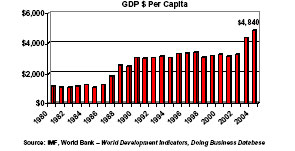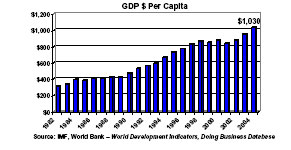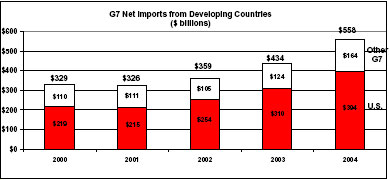Fact Sheet
Bureau of Economic and Business Affairs
Washington, DC
September 13, 2005
The Monterrey Consensus: Progress From Partnership PDF version PDF version
Developing countries are the driving force for their own growth and development.
The Monterrey Consensus calls on:
- Developing countries to adopt sound economic and social policies that will help mobilize resources from all sources – public and private, foreign and domestic.
- Developed countries to support those efforts through an open trading system, private capital flows and additional development assistance.
Leading Actions of the Monterrey Consensus
- Mobilizing domestic financial resources
- Mobilizing international resources
- International trade as an engine for development
- Increasing financial and technical cooperation
- Addressing external debt
Mobilizing Domestic and International Resources for Development
"An enabling domestic environment is vital for mobilizing domestic resources, increasing productivity, reducing capital flight, encouraging the private sector, and attracting and making effective use of international investment and assistance." Monterrey Consensus, 2002
Developing Economies in 2003:
Export Earnings 1/………..….. $2.9 trillion
Domestic Savings 2/…….…...... $2.5 trillion
Flows to Developing Economies in 2003:
Foreign Direct Investment 3/…. $152 billion
Workers’Remittances 3/…...…$116 billion
Portfolio Investment Flows 3/…. $25 billion
Private Giving 4/…..…..……….. $15 billion
Official Dev. Assistance (ODA) 4/ $70 billion
|  |
Source: 1/ MF DOT 2005, 2/ IMF WEO 2005, 3/ World Bank Global Development Finance 2005
4/ OECD/DAC –Private Giving reflects net grants by NGOs from DAC donor countries –does not represent all charitable contributions.
-Official Development Assistance are bilateral ODA flows from DAC donor countries,multilaterals, and Non-DAC countries.
Mobilizing Resources for Development: Good Governance
"Good governance is essential for sustainable development. Soundeconomic policies, solid democratic institutions responsive to the needs of the people and improved infrastructure are the basis for sustained economic growth, poverty eradication and employment creation." Monterrey Consensus, 2002

Source: World Bank –Governance Matters Indicators
Mobilizing Resources for Development: A Sound Business Climate
"We will…foster a dynamic and well functioning business sector, while improving income growth and distribution, raising productivity, empowering women and protecting labour rights and the environment." Monterrey Consensus, 2002

Source: World Bank –Doing Business Database
 Botswana: Botswana:
Investing Resources for Social and Economic Development
- Transparency International ranks Botswana as one of the least corrupt countries in Africa.
- The cost to start a business in Botswana is one of the lowest in Africa.
- The percentage of females enrolled in secondary school increased from 40% in 1990 to 75% by 2002.
- Since independence, Botswana has had the fastest per capita income growth in the world.

 Sri Lanka: Sri Lanka:
Good Governanace and Social Investment Leading to Strong Economic Outcomes
- Regulatory quality in Sri Lanka is rated higher than any other country in South Asia.
- Sri Lanka’s level of investment in health and education is on par with many developed countries.
- Sri Lanka’s adult literacy rate is 92%, compared to an average literacy rate of 59% for all of South Asia.
- In the past two decades, GDP per capita nearly tripled to $1,030.

 Ghana: Ghana:
Promoting Economic Growth through Government Accountability
- The World Bank rates Ghana’s "voice and accountability"as one of the highest in Africa.
- The World Economic Forum rates Ghana as one of the ascending competitive nations in Africa.
- FDI and receipts from tourism are at record highs in Ghana.
- Ghana has maintained strong and consistent GDP growth for the past 20 years.

International Trade as an Engine for Development
"A universal, rule-based, open, non-discriminatory and equitable multilateral trading system…can substantially stimulate development worldwide, benefiting countries at all stages of development." Monterrey Consensus, 2002

Increasing Financial and Technical Cooperation for Development
"Official development assistance (ODA) plays an essential role as a complement to other sources of financing for development, especially in those countries with the least capacity to attract private direct investment." Monterrey Consensus, 2002

Increasing Aid Effectiveness: The Millennium Challenge Account
|
The Concept:
Give countries an incentive to adopt policies that reduce poverty, spur sustainable growth and help make aid effective:
|
The Reality:
In its first 19 months, the Millennium Challenge Corporation:
|
- Good policy: MCA rewards countries that govern well, invest in health and education, and provide a positive business climate.
- Country ownership: MCA countries design and implement their own programs with MCC help
- Measurable Results:MCA Compacts identify measures of success with clear goals, benchmarks and responsibilities from the start.
|
- Is working with 30 countries representing over 400 million people.
- Has approved Compact and pre-Compact funding of nearly $1 billion with more Compacts to come.
- Has provided an effective incentive cited by several countries that are undertaking policy reforms.
|
Increasing Economic Engagement: New Initiatives
Developing Countries:
- New Partnership for Africa’s Development (NEPAD)
- African Peer Review Mechanism
- Remittance Projects
- BMENA Initiative
- CAFTA
| Developed Countries:
- G8 Africa Action Plan and Gleneagles agreement to increase support for Africa
- Business Climate Pilot Projects
- Transparency Compacts
- Trade Capacity Building
- Global Fund, President’s Emergency Plan for AIDS Relief (PEPFAR)
- Education for All Initiative
|
Reducing External Debt
"Sustainable debt financing is an important element for mobilizing resources for public and private investment. Debtors and creditors must share the responsibility for preventing and resolving unsustainable debt situations." Monterrey Consensus, 2002
- The Heavily Indebted Poor Countries (HIPC)Initiative is a multilateral effort to reduce excessive debt burdens faced by the world’s poorest nations.
- The G8 recently agreed to support 100% debt cancellation of multilateral debt(IDA, IMF,AfDF) forHIPCs; immediate application = $40 billion for 18 countries. Could reach $56 billion with application to remainingHIPCs.
- In 2003, the Paris Club focused their approach on overall levels of debt sustainability, expanding debt relief to non-HIPC countries.
Monterrey Consensus: Challenges Ahead
"The developing countries and countries with economies in transition face special difficulties responding to…challenges and opportunities." Monterrey Consensus, 2002
- Address the threat that HIV/AIDS, malaria, and tuberculosis pose to development gains.
- Translate economic growth into broad-based poverty reduction more rapidly.
- Diversify economic activity to ensure high quality jobs are available to the upcoming generation of highly skilled workers.
Monterrey Consensus: Next Steps
"Recognizing that peace and development are mutually reinforcing,we are determined to pursue our shared vision for a better future…" Monterrey Consensus, 2002
- Continue to expand trade and access to global markets for developing countries
- Successful completion to Doha round of WTO
- Reduce trade barriers between developing countries
- At 2005 HLE, reinforce the balanced approach of Monterrey Consensus, coupling increased ODA with good governance, transparency and measurable results.
- Fund new, innovative programs such as the MCA, business climate pilots, and transparency compacts
| 
 PDF version
PDF version 
